Oscar
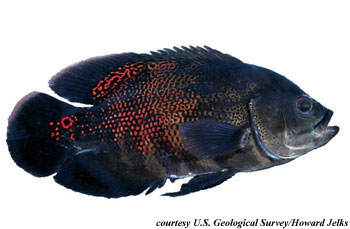
Astronotus ocellatus
These fresh water cichlids prefer slow-moving water with sunken branches and logs to hide behind. They’re usually a gray-brown to olive green mottle of colors, with an orange-ringed black ‘eye’ spot (or two) at the tail to confuse predators. These stocky, oval fish form breeding pairs to tend to and aggressively defend their offspring. The oscar is one of the many cichlids popular in the aquarium trade, often bred and cross-bred to create unusual varieties.
Order: Perciformes
Family: Cichlidae
Genus: Astronotus
Species: ocellatus
Common Names
Common English names include oscar, velvet cichlid, red oscar, tiger oscar, and marble cichlid. Other names are acará-açu (Portuguese), acará-grande (Portuguese), acarahuazú (Spanish), acaraú-açu (Portuguese), aluago elselepo (Galibi), apaiari (Portuguese), astronotus (French), bola-de-ouro (Portuguese), cará-grande (Portuguese), cará-açu (Portuguese), carahuazú (Spanish), cichlidé oeil de paon (French), corró-baiano (Portuguese), corró-chinês (Portuguese), crombier (Creole), dorminhoco (Portuguese), krobié rouj (Creole), masug (Palicur), paya (Creole), pfauenaugenbuntbarsch (German), and pielegnica pawiooka (Polish).
Importance to Humans
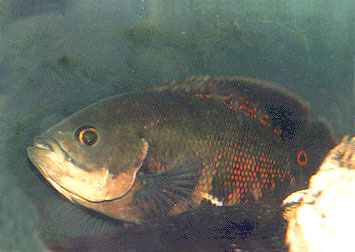
The oscar is a very popular aquarium fish in North America and Europe. And although adults require large aquaria, oscars breed readily when maintained properly and are often characterized as very “personable” pets by their keepers. The breeding populations of oscars established in areas of South Florida stem from a deliberate stocking event in Dade county by aquarium fish farms in the late 1950s. The many interconnected canals of South Florida along with transportation by individual anglers to new areas has aided the dispersal of this introduced species. Established in no less than 6 counties, the oscar is one of the few exotic fishes reproducing in the marginalized habitats of South Florida to have obtained a foothold in Everglades National Park. The direct effect of the oscar on native species or the ecological balance of the park is unknown, but owing to the fact that native sunfishes in the region possess similar habits and ecological needs to that of the oscar, there is concern regarding the potential for harm.
Dispersal northward in Florida appears to be restricted by temperature. A 1982 Florida Game and Freshwater Fish Commission study determined the mean lower lethal temperature for this species is 12.9° C. In its native range, the oscar is valued by artisanal fishers as a food fish.
Danger to Humans
The oscar poses no danger to humans.
Conservation
> Check the status of the Oscar at the IUCN website.
The IUCN is a global union of states, governmental agencies, and non-governmental organizations in a partnership that assesses the conservation status of species. Oscar, Astronotus ocellatus is listed as Least Concern.
Geographical Distribution

Although the type locality for Agassiz’ specimen was published as “Atlantic Ocean” the oscar is a strictly freshwater species restricted to the Rio Ucayali drainage and upper Amazon river of Peru and Brazil. The error committed by Agassiz is easily attributable to the fact that many early species descriptions were based on specimens shipped to zoologists from far-flung locales and often these specimens were accompanied by little in the way of specific locality data. Indeed, there are many instances of early species descriptions with locality errors similar to the case of the oscar. A non-native population of oscars is well established in South Florida, USA.
Habitat
Oscars show a preference for slow moving waters that afford them cover in the form of sunken branches and logs. This cichlid spends a great deal of time “resting” in areas of cover. Captive oscars are commonly observed to rest on the substrate at night.
Biology
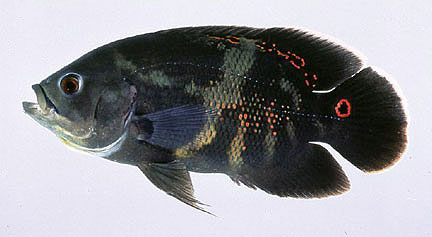
Distinctive Features
The oscar is a large, somewhat stocky cichlid with an oval shaped body, a large head, large eyes, and a large mouth. The first dorsal fin is spinous; the second is composed of soft rays and has a rounded shape. The anal fin is spinous anteriorly and also possesses a rounded edge. Both the base of the soft dorsal and anal fins are scaled.
Coloration
Oscars are olive-green to gray to chocolate brown in base color with a mottling of some or all of these colors. A large black spot surrounded by an orange ring present on either side of the base of the upper caudal peduncle is a striking characteristic of this species. These conspicuous bilateral ocelli or “eye-spots” (some individuals may possess more than one per side) serve in an anti-predator capacity, causing confusion as to which end of the fish is the head. Oscars appear to suffer less injury from fin-nipping piranhas than do other similar cichlid fishes lacking eyespots and living within the same range. Eyespots or disruptive coloration associated with the actual eyes are fairly common traits amongst fishes, and such characteristics have independently evolved along many separate evolutionary lines. Additionally, more than one study has determined that the eyespots of oscars serve as important cues in intraspecific communication, particularly during courtship and agonistic displays.
A number of artificially selected aquarium color varieties exist including an albino morph among others. Individuals with greatly elongated fins have also been produced for the aquarium hobby.
Juveniles are strikingly marked fishes characterized by a series of prominent wavy white and orange bars and numerous small white spots randomly distributed on the head.
Dentition
Like all cichlids, oscars possess teeth not only in their jaws but a set of pharyngeal teeth as well. Teeth in the jaws are small and used for grasping while those in the throat (the pharyngeal teeth) manipulate and process prey items.The type and arrangement of teeth on the pharyngeal jaw plates are one of many important characters useful to systematists in deciphering the evolutionary relationships of cichlids and much study on this important feature has been published.
Size, Age, and Growth
Captive oscars commonly live 10-20 years. The oscar is a large cichlid reaching lengths of 33cm and a maximum weight of approximately 1.1kg.
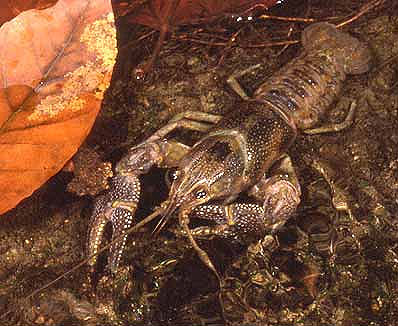
Food Habits
The natural diet of oscars consists largely of smaller fishes, crustaceans, gastropods, and aquatic insects or insect larvae. Although oscars are generally sluggish or inactive, they are capable of ambushing and capturing fleeing prey over short distances. Oscars in captivity exhibit voracious, somewhat indiscriminate feeding habits.
Reproduction
No well defined external differences are discernable for male and female oscars although males tend to be larger and more colorful. Breeding oscars defend their spawning sites, nest, and young quite fiercely. Male oscars may lock jaws in disputes over territory or mate selection. In captivity male and female have been observed to jointly prepare the breeding site. Eggs are adhesive and laid on a flat open surface cleared by the breeding pair. Hatching of eggs is temperature dependent, but typically occurs within 3 to 4 days. A single spawning may consist of as many as 1000 – 2000 eggs. Like most cichlids, oscars tend and guard their young. Non-native populations in South Florida are observed to spawn primarily during summer months.
Predators
Oscars rely on their cryptic coloration and eyespots to elude or confuse predators. Generally sluggish, oscars are capable of swimming away quite rapidly over short distances. Nonetheless, all age classes of oscars are susceptible to a suite of predators including invertebrates, fishes, wading birds and reptiles.
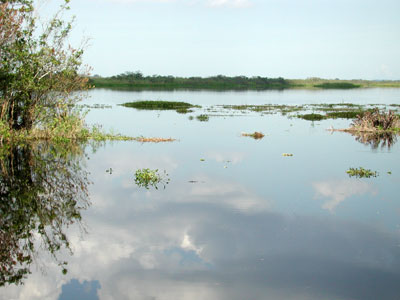
Parasites
Captive oscars are known to be quite susceptible to “hole in the head” disease, a condition caused by the protozoan Hexamita. Little is known regarding the parasites and diseases of wild oscars.
Taxonomy
The oscar was formally described in 1831 as Lobotes ocellatus by the famous 19th century zoologist and founder of Harvard University’s Museum of Comparative Zoology, Jean Louis Rodolphe Agassiz. The genus Lobotes however, is entirely marine, and fishes of this genus, known as tripletails (Lobotidae) are of no meaningful relation to cichlids. It is surmised that Agassiz chose Lobotes in describing the oscar based on the fact that he believed his specimen or specimens to have been collected in the Atlantic Ocean. Considering the similarity in appearance of the oscar to the marine tripletails and the erroneous locality information, the original placement of the oscar in Lobotes is not surprising. Current taxonomic placement of the oscar is in the South American cichlid genus Astronotus. Astronotus is derived from the Greek words “astra” = ray and “noton” = back. Ocellatus is Latin for spotted, referring to the spotted pattern on the body of this fish. Synonyms include Acara compressus Cope 1872 and Hyposticta acara Cope 1878. Astronotus has long been considered a monotypic genus, but recent studies indicate that a number of other species of “oscar” abound in South America. Astronotus ocellatus as originally described appears to be restricted to Peru and Brazil.
Prepared by: Robert H. Robins